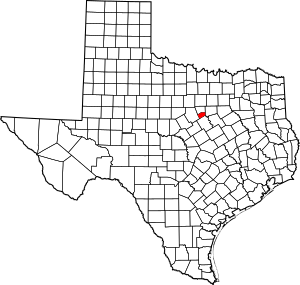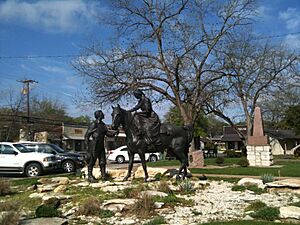Somervell County, Texas facts for kids
Quick facts for kids
Somervell County
|
|
|---|---|

The Somervell County Courthouse in Glen Rose
|
|

Location within the U.S. state of Texas
|
|
 Texas's location within the U.S. |
|
| Country | |
| State | |
| Founded | 1875 |
| Named for | Alexander Somervell |
| Seat | Glen Rose |
| Largest city | Glen Rose |
| Area | |
| • Total | 192 sq mi (500 km2) |
| • Land | 186 sq mi (480 km2) |
| • Water | 5.5 sq mi (14 km2) 2.9%% |
| Population
(2020)
|
|
| • Total | 9,205 |
| • Density | 47.94/sq mi (18.51/km2) |
| Time zone | UTC−6 (Central) |
| • Summer (DST) | UTC−5 (CDT) |
| ZIP Codes |
76043
|
| Area code | 254 |
| Congressional district | 25th |
Somervell County is a small county located in the state of Texas, USA. It sits on a high area called the Edwards Plateau. In 2020, about 9,205 people lived here. The main town and county seat is Glen Rose. The county gets its name from Alexander Somervell, who was an important leader for the Republic of Texas.
Somervell County is part of the Granbury micropolitan area. This means it's connected to a larger town, Granbury, for jobs and services.
The county is also home to the Comanche Peak Nuclear Generating Station. This is one of only two nuclear power plants in Texas.
Contents
History of Somervell County
Native American Tribes
Long ago, different Native American tribes lived in this area.
- The Caddo tribe, including the Anadarko group, had villages along the Trinity and Brazos Rivers.
- Another Caddo group, the Wichita, also lived here. By 1860, these tribes had moved to Oklahoma.
The Tonkawa tribe were skilled hunter-gatherers. They often traded with their friends, the Caddo and Karankawa tribes. Like some other tribes, the Tonkawa decorated their bodies and faces with tattoos. Some Tonkawa men even worked as scouts for the Texas Rangers and the United States Army. As the Comanche tribe moved into the area, the Tonkawa were pushed out. They eventually moved to a reservation and then to Oklahoma.
Comanche groups often raided settlers until they were also moved to Oklahoma after 1875.
How the County Was Formed
Somervell County was officially created in 1875. It was formed from a part of Hood County. The town of Glen Rose was chosen as the county seat.
Early trading posts, called Torrey Trading Houses, were set up to help build good relationships with Native American tribes. They traded goods and even helped get back stolen horses and people who had been captured. Later, George Barnard and his brother Charles took over the business. Charles Barnard married Juana Josefina Cavasos Barnard, who had been captured by Comanches when she was young.
Somervell County got its first courthouse in Glen Rose in 1882. Sadly, this courthouse and all its records burned down in 1893. The second and current courthouse was built in 1894. Its roof and clock tower were damaged by a tornado in 1902. Because there wasn't much money, the clock tower was removed during repairs. In 1986, the courthouse was restored to look like its original design.
A private school, Glen Rose Collegiate Institute, taught students from 1889 to 1910. It closed because more public schools opened, and fewer students enrolled.
During the 1930s, the Works Progress Administration (WPA) helped Glen Rose. They built new water and sewage systems, school buildings, and even dams.
The Comanche Peak Nuclear Power Plant started operating in the mid-1970s. It provides jobs for over 1,000 people. The Squaw Creek Reservoir, which cools the power plant, is also a popular place for fun activities.
Dinosaur Discoveries
In 1908, a big flood in the Paluxy River uncovered amazing three-toed prints from the Cretaceous period. A high school student named George Adams found them in the riverbed. He told his principal, Robert McDonald, about the discovery.
Later, in the 1930s, George Adams started selling fake "giant man tracks" to tourists. This led to a big debate about whether humans lived at the same time as dinosaurs. In 1934, another resident, Charlie Moss, found footprints of four-toed sauropods (long-necked dinosaurs). Jim Ryals, another local, dug up real dinosaur prints and sold them.
A paleontologist named Roland T. Bird from the American Museum of Natural History saw the fake "giant man tracks" in a shop. Even though he knew they were fake, he was curious enough to visit Somervell County. Bird's visit led to a two-year project to uncover more dinosaur prints. Today, some of the best-preserved dinosaur tracks in the United States are kept in museums like the American Museum of Natural History and the Smithsonian Institution.
The land along the Paluxy River became Dinosaur Valley State Park in 1968. The park officially opened to the public in 1972, allowing everyone to see these incredible dinosaur footprints.
Geography of Somervell County
Somervell County covers about 192 square miles. About 5.5 square miles of this area is water. It is the second-smallest county in Texas. Only Rockwall County is smaller.
Main Roads

Neighboring Counties
Somervell County shares borders with these other counties:
- Hood County (to the north)
- Johnson County (to the east)
- Bosque County (to the south)
- Erath County (to the west)
People of Somervell County (Demographics)
| Historical population | |||
|---|---|---|---|
| Census | Pop. | %± | |
| 1880 | 2,649 | — | |
| 1890 | 3,419 | 29.1% | |
| 1900 | 3,498 | 2.3% | |
| 1910 | 3,931 | 12.4% | |
| 1920 | 3,563 | −9.4% | |
| 1930 | 3,016 | −15.4% | |
| 1940 | 3,071 | 1.8% | |
| 1950 | 2,542 | −17.2% | |
| 1960 | 2,577 | 1.4% | |
| 1970 | 2,793 | 8.4% | |
| 1980 | 4,154 | 48.7% | |
| 1990 | 5,360 | 29.0% | |
| 2000 | 6,809 | 27.0% | |
| 2010 | 8,490 | 24.7% | |
| 2020 | 9,205 | 8.4% | |
| U.S. Decennial Census 1850–2010 2010 2020 |
|||
| Race / Ethnicity (NH = Non-Hispanic) | Pop 2000 | Pop 2010 | Pop 2020 | % 2000 | % 2010 | % 2020 |
|---|---|---|---|---|---|---|
| White alone (NH) | 5,763 | 6,595 | 7,011 | 84.64% | 77.68% | 76.17% |
| Black or African American alone (NH) | 13 | 54 | 39 | 0.19% | 0.64% | 0.42% |
| Native American or Alaska Native alone (NH) | 39 | 45 | 49 | 0.57% | 0.53% | 0.53% |
| Asian alone (NH) | 17 | 40 | 55 | 0.25% | 0.47% | 0.60% |
| Pacific Islander alone (NH) | 0 | 1 | 0 | 0.00% | 0.01% | 0.00% |
| Other Race alone (NH) | 4 | 24 | 33 | 0.06% | 0.28% | 0.36% |
| Mixed Race or Multiracial (NH) | 58 | 105 | 331 | 0.85% | 1.24% | 3.60% |
| Hispanic or Latino (any race) | 915 | 1,626 | 1,687 | 13.44% | 19.15% | 18.33% |
| Total | 6,809 | 8,490 | 9,205 | 100.00% | 100.00% | 100.00% |
In 2000, there were 6,809 people living in the county. There were 2,438 households, and 1,840 families. The population density was about 36 people per square mile.
- About 37.4% of households had children under 18.
- 61.7% were married couples.
- 24.5% were not families.
- The average household had 2.73 people.
- The average family had 3.17 people.
The median age in the county was 37 years old. For every 100 females, there were about 99.6 males.
The median income for a household was $39,404. For a family, it was $46,458. About 8.6% of the population lived below the poverty line. This included 10.3% of those under 18.
Media in Somervell County
Somervell County has a local newspaper called the Glen Rose Reporter. There are also online news sources like the Somervell County Salon (a local blog with videos) and GlenRose.News. Television news for the area comes from stations in Dallas-Fort Worth and the Central Texas region (Waco, Temple, Killeen).
Communities in Somervell County
City
- Glen Rose (This is the county seat, the main town where the county government is located.)
Unincorporated Communities
These are smaller towns or areas that are not officially organized as cities.
See also
 In Spanish: Condado de Somervell para niños
In Spanish: Condado de Somervell para niños



